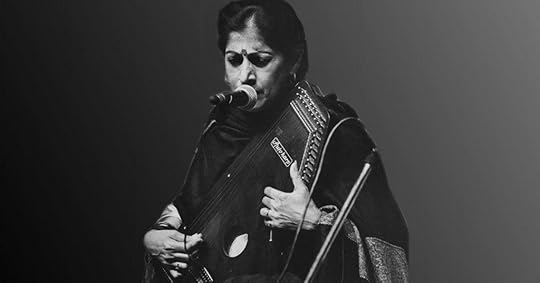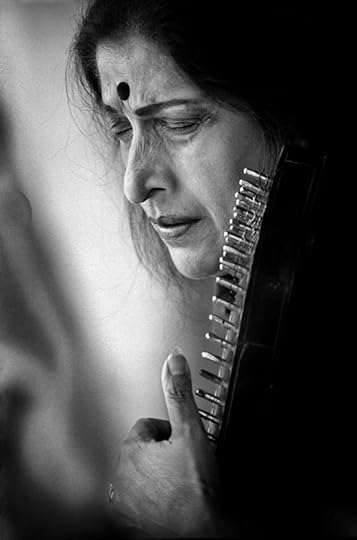Kishori Amonkar: Between The Notes
She struggled to place her voice in a room where her mother’s voice towered.

Kishori was twenty-five when she lost her voice. Her mother Mogubai said it was only an interruption in her sadhana (practice) and she would recover it soon.
‘Your voice has reached its pinnacle. It will return through you. It is as sign that your voice no longer belongs to you but to your listeners. They are the sadhya (destination) it desires,” she said.
Kishori was trying to comprehend her mother’s complex words with a poker face when Mogubai switched. ‘You are right now in a spiritual state of silence before the storm,’ Mogubai tried to cheer her up.
Kishori forced a smile. For her, her voice was a dialogue with the divine, and that had stopped. Her daily riyaaz had stopped. She was upset. On her mother’s insistence after consultation with a sadhu, she began taking ayurvedic herbs to restore her voice.
One uneventful morning, she was standing in her room, looking out of the window, watching the breeze tickle the leaves of a peepal tree. A lilting sound reached her ears like the tinkling of silver bells. A leaf danced in the air and floated into her palm when she stretched a hand out for its free fall. She chuckled. A geyser of notes began to rise up her larynx. Her mother was rehearsing in the next room, reaching for the ‘re’ note in raag Shuddh Kalyan. Kishori tried to grasp the ‘re’ of raag Bhoop, soaring in the opposite direction of her mother’s voice. Her voice returned with wings. She sang like a bird in flight.
Mogubai had to stop singing and walk into Kishori’s room. She watched her daughter with pride. Mogubai had taught her raag Bhoop for fifteen months straight. It had dried Kishori’s voice. The voice had returned after two years of complete silence. Mogubai said her voice could induce a trance-like effect in listeners.
‘Your voice has finally found its instrument. Remember that you are a tanpura now. You will have to be more careful with this voice,’ Mogubai said. ‘It is not for entertainment.’
Kishori looked at the glazed leaf in her palm as if it was a feather that had fallen off her back in flight.
Kishori’s new voice worked like a miracle. Fans flocked to concerts like devotees seeking epiphany. One thing lead to another, and soon enough Kishori was singing a solo in a film. Mogubai objected to Kishori singing the title song Geet Gaya Patharon Ne in the eponymously titled film. The song’s popularity announced her entry into film music but it was short-lived.
https://medium.com/media/e77a0ea07ad4747b386ad1beccc04d9d/href‘You will not touch my tanpura,’ her mother said. ‘We don’t sing for money and fame.’
Kishori did not return to film music. She became her mother’s most devoted pupil, often submissively allowing herself to be used as an example to set a standard of intent in the music room. Mogubai would sing the sthayi and the antara just once or twice to insure Kishori was focused. She wanted Kishori to surpass her own singing skills, and that required training Kishori with rigidity.
Twenty-five years later, when Kishori composed and sang in another film Drishti, Mogubai reminded her that the filmmaker would misuse her tunes. A lovemaking scene featured Kishori’s vocals. It naturally infuriated Mogubai, a traditionalist who wished the best for her daughter. Yet again, she reminded Kishori not to be swayed by glamour.
‘Why do you not listen to me?’ Mogubai said. ‘When will you do your riyaaz if you waste you time in films and concerts?”

With her head bowed, Kishori tried to contain the rebel growing older inside her. Time and again her mother was correcting a version of herself in her daughter. Kishori was a bird shedding her feathers in an open cage.
After her mother’s death, Kishori became a stickler like her mother. She spent ten to twelve hours in practice. When she stepped out, she reminded others that she was in communion with the divine. She grew irritable with an undisciplined audience, did not talk to the media, and was impatient with inefficient show organisers –things that she had seen her mother silently suffer.
Kishori’s voice had now begun to show signs of wear and tear. She would arrive late on stage and start by clearing her throat, take occasional sips of water and stretch a taan to climb octaves and reach shrutis (micro-notes). An hour would pass without her reaching the raag she was trying to scale, sometimes with great difficulty. Listeners could intuit a range of emotions, from sadness to happiness, but patience was key to both audience and performer.
Although she had her own identity, she was beginning to sound more and more like her mother. It bothered her that she was turning into her mother. Kishori had to find a way to communicate to her mother that she no longer needed her guidance.
At age 84, Kishori decided to perform her final concert to announce her sabbatical from singing. Wearing her trademark big red bindi, glasses, and her hair in a loose bun, she got up on stage draped in a shot-silk saree with a red and gold border. Holding the swaramandal in one hand, adjusting the pallu of her saree across her shoulder, she was a picture of dignity and grace. She sat on a white gaddi decorated with artificial flowers and accompanied by her musicians on the tabla, harmonium, violin and tanpura.
An hour into her performance, the audience was enthralled by her khatkas, meends, gamaks, and murkis — cluster of ornamental notes. Midway through an alaap, she sang Payaliya Jhankar in raag Puriya Dhanashree. She heard a tinkle of silver bells. She opened her closed eyes and looked up into the audience. She saw her mother, standing, and smiling. Kishori believed that when she hit the sublime note of a raag, it manifested itself in person. She could reach her mother through this abstraction in music.
https://medium.com/media/4fffd877f68ed0225f96c72abcb9cbd7/hrefThe transcendental effect of her voice had not only reached its audience, but also herself, like a leaf wilfully resting in her own palm. Her invocation had brought her mother back. Kishori ended the concert without informing the audience about her break from music. She didn’t need to. Her mother’s presence in the audience confirmed it. They were not one and the same.
Kishori died peacefully in her sleep a week later.
Her swaramandal was gifted to a music school. Students rushed to touch the sacred relic. It held her touch, her notes, and her soul-stirring voice, like a leaf dancing in the air, suspended somewhere between the here and the eternal.
https://medium.com/media/be7ecacb1b2f39ac2e9f1918d747e921/hrefDisclaimer: This is a work of fan fiction or more formally known as real person fiction. It is not for any commercial use. Read more on Real Person Fiction here.




